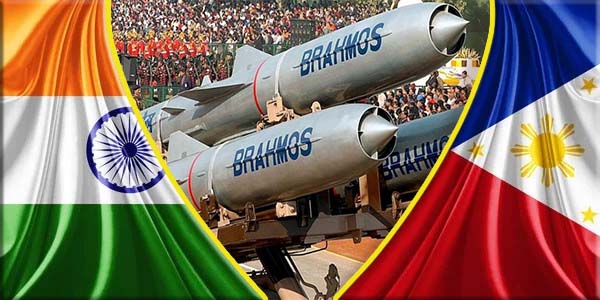
- In April 2024, India exported its first batch of BrahMos missiles to the Philippines in a historic $375 million deal, reflecting years of groundwork since 2022 and marking India’s entry into Southeast Asian defence exports.
- The deal is driven by China’s aggressive actions in the South China Sea and along the India-China border (Doklam 2017, Galwan 2020), aiming to counter Chinese assertiveness and protect regional interests.
- Strengthening India-Philippines ties enhances regional stability, reinforces ASEAN centrality, and aligns with India’s broader Indo-Pacific and Act East strategic policies.
- The BrahMos export establishes a precedent for future defence cooperation with other Southeast Asian nations, potentially expanding India’s strategic influence while promoting security partnerships in the region.
The Government of India exported its first batch of BrahMos missiles to the Philippines in April 2024[1]. However, the background of this deal was prepared since early 2022, when India, along with Russia, agreed to export the missile worth 345 million in a first-ever historic deal with the Philippines in the last week of January[2]. It was a watershed moment for many in the Indian Defence establishment and those involved in the Defence research, particularly the Defence Research and Development Organisation (DRDO). However, for many in the policy circles, primarily the Academia and serving Defence officials, this was not something unexpected, and the foundations for such a deal had been set ever since China became aggressive towards India in 2017 and 2020 with its continued sinister yet aggressive proxy wars in the Doklam plateau and the Galwan valley, respectively.
It is China’s arrogant behaviour with its Asian peers that set the ball rolling for such a deal, as China has not only been bullying India but also many countries of Southeast Asia over the past decades, especially in the South China Sea.
China’s Aggression in the South China Sea
China, for many years, projected its aggression and brute nature on the countries of the Southeast Asian region, primarily in the South China Sea, with utter disregard for international norms. Under such circumstances, China has made more foes than allies with its aggressive behaviour.[3]
There is no doubt that the South China Sea is commercially important for the rest of Asia, as it has immense potential for fisheries, hydrocarbons and serves as a major commercial shipping lane for the naval fleets of the countries of Southeast Asia, Japan, India, China, and these countries have had competing claims with each other over pristine archipelagos.[4]
China has been quite notorious when it comes to its claims in the South China Sea as it tries to violate the sovereign exclusive economic zones (EEZ) of Countries such as Philippines, Taiwan, Vietnam and also by the disregards for international law, where these countries have had tumultuous relations with China and over the years tensions have grown between countries of South East Asia and China such that these countries have increased their military spending due to the bullying tactics of the Chinese navy[5]. The confrontation between China and the Philippines is not something recent; however, it is a dispute that has been raging on for decades.
China’s Dispute with the Philippines
China’s relationship with the Philippines has been tumultuous with ups and downs over the decades. These disputes have been mostly of a maritime nature and competition over territorial claims of archipelagos.[6]
Moreover, when the Philippines lodged a legal complaint against China in the Permanent Court of Arbitration (PCA) at the Hague in 2016, China objected to the court ruling despite the court decision being in favour of the Philippines and China having refused to take part in the Court proceedings. While this is a matter of discord between China and the Philippines, Beijing has also been a troublemaker with India ever since 1962.
China’s Dispute with India
Territorial disputes between India and China have been going on ever since the Indo-China war of 1962[7]. China has been offensive with India in the events that unfolded in 2017 at the Doklam plateau and 2020 at the Galwan valley, respectively. Doklam and Galwan have witnessed ugly confrontations resulting in casualties from both sides.[8] India has continued seeing Chinese incursions into the North East Indian state of Arunachal Pradesh for some time now, and since such fears are quite warranted, it is felt by New Delhi that exporting Defence arsenals will be the game-changer in this showdown.
India and the Philippines’ Bonhomie
While China became aggressive towards both India and the Philippines over the recent years, the timing was ideal for India to export the missiles to the Philippines. Therefore, India entered into the missile deal primarily with two objectives in mind.[9] Keeping an eye on China’s growing assertiveness in the South China Sea is crucial for India’s strategic interests. At the same time, maintaining closer ties with Southeast Asian countries helps promote regional stability and counterbalance China’s influence. Through this engagement, the Government of India believes it can enhance ‘ASEAN Centrality’[10] in its Indo-Pacific vision by trying to reach out to like-minded countries in South East Asia.
Way Forward
While this deal marks a first-of-its-kind defence export from India to a Southeast Asian country, it remains to be seen how India will respond to countries such as Indonesia or Vietnam in selling some of its high-end defence arsenal to such countries, amidst an ongoing crisis with China. India, it seems, is trying to gain allies in the showdown with China. However, time will reveal whether such defence deals will be a success story under the framework of the Act East Policy, India’s broader Indo-Pacific strategy, and whether they truly represent a game-changer for both India and the Philippines in the region amid China’s assertiveness.
References:
- [1] Dinakar Peri, ‘India delivers first batch of BrahMos to the Philippines’, The Hindu, April 20, 2024, https://www.thehindu.com/news/national/india-delivers-first-batch-of-BrahMos-to-philippines/article68084161.ece
- [2] Dinakar Peri, ‘In first BrahMos missile export order, Philippines approves $374 million contract’, The Hindu, January 15, 2022, https://www.thehindu.com/news/national/in-the-first-BrahMos-missile-export-order-philippines-approves-374-mn-contract/article38272238.ece ( Accessed on February 20th 2022)
- [3] Dipanjan Roy Chaudhary, ‘China’s aggression in South China Sea faces strong global pushback’, The Economic Times, October 29, 2021 https://economictimes.indiatimes.com/news/defence/chinas-aggression-in-south-china-sea-faces-strong-global-pushback/articleshow/87351835.cms (Accessed on February 21st 2022)
- [4] Premesha Saha, ‘How India’s BrahMos deal is not just about the Philippines’, Observer Research Foundation, February 12, 2022 https://www.orfonline.org/research/how-indias-BrahMos-deal-is-not-just-about-philippines/ (Accessed on February 22nd 2022)
- [5] Priyanka Pandit, ‘The Long Shadow of Sea Power and the South China Sea dispute’, The Hindustan Times, January 22, 2022, https://www.hindustantimes.com/ht-insight/international-affairs/the-long-shadow-of-sea-power-and-the-south-china-sea-dispute-101642851258166.html (Accessed on February 25th 2022)
- [6] Mudassir Qamar, ‘China-Philippines South China Sea dispute PCA award and Post arbitral relations’, Indian Council of World Affairs Interns corner, January 5, 2022 https://www.icwa.in/show_content.php?lang=1&level=1&ls_id=6872&lid=4680 (Accessed on February 25th 2022)
- [7] Maj. Gen. Sheru Thapliyal, ‘1962 war: A Critical Analysis’ Indian Defence Review, March 30: http://www.indiandefencereview.com/spotlights/1962-war-a-critical-analysis/ (Accessed on February 27th 2022)
- [8] Josy Joseph, ‘What is the Doklam issue all about?’, The Hindu, January 27,2018, https://www.thehindu.com/news/national/what-is-the-doklam-issue-all-about/article22536937.ece (Accessed on February 28th 2022)
- [9] Press Trust of India, ‘PM Modi highlights ASEAN’s centrality in India’s vision for Indo Pacific’, NDTV, October 28, 2021, https://www.ndtv.com/india-news/pm-modi-highlights-aseans-centrality-in-indias-vision-for-indo-pacific-2591594
- [10] K. Yhome, ‘ASEAN centrality and the emerging great power competition’, Observer Research Foundation Raisina debates, October 30, 2020, https://www.orfonline.org/expert-speak/asean-centrality-and-the-emerging-great-power-competition/
John Guite is Coordinator-Corporate and International Relations, Malla Reddy (Deemed to be) University, and Vinay Bhushan is an Assistant Professor at Bangalore University. Views expressed are the author’s own.
